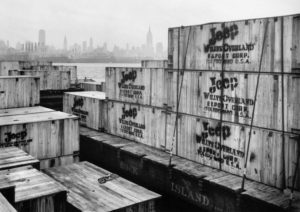

When I was a teenager, my Dad bought a Willys “station wagon.” It was a great little vehicle and I loved it! Mom and Dad would load my girlfriends and me, along with picnic baskets and coolers, for our day-at-Zuma-Beach (just north of Malibu). What great times we had. In those olden days, if you could only drive a vehicle with an “automatic transmission,” your license was “flagged,” accordingly. So, Dad insisted that I should learn to drive the “standard” transmission. Dad even taught me to parallel park driving the Willys. Once I had my driver’s license, I was permitted to drive it (if, and only if, I could demonstrate that I could drive in reverse gear out of our tricky driveway. What fun!
I was prompted to write this article when I stumbled across a short online article about “Jeeps-in-a-Crate for sale.” The article went on to describe an ad that had appeared in magazines like Boy’s Life or Popular Science in the 40s or 50s about ‘Army Surplus Jeeps for sale for “Only $50.”
Sounds too good to be true? That’s because it wasn’t. It was a SCAM. The scammers weren’t buying Jeeps for people. Rather they were sending pamphlets with information on how to bid at government auctions. And the same information was available from the U.S. Government for free! And even then, very few complete Jeeps were available for sale. Most Jeeps were scrapped, leaving only spare parts for sale.

But who would want a Jeep anyway? They carried a 1/4 ton, they were a four-wheel drive vehicle. Nevertheless, it was advertised as a great boon to civilians. With the end of the war in sight, Popular Science began encouraging the market for surplus Jeeps by running a contest in March 1945.
The magazine encouraged readers to offer their ideas on the theme “how I’ll use surplus goods.” It was suggested that the Jeep could be a tractor, a power generator, a truck, a pick–up. Everyone had to have a Jeep! They have become very popular for work and recreational use, right up to the present time.
But it wasn’t army Jeeps that answered the demand, but rather Jeeps designed for civilian use. The first CJ, or Civilian Jeep, was produced in 1941 and was called the CJ2A. And Jeeps like the Wrangler and Cherokee are popular as family vehicles nowadays.
Of course, the Jeep wasn’t built for civilians. It had an important military purpose. The military needed a tough vehicle that could carry heavy loads, pull heavy objects and move quickly over rough ground. 648,000 Ford GPW’s and Willys MB’s were built during World War II – 15% of military vehicles produced were Jeeps. The Jeep was used by every branch of the U.S military, with an average of 145 assigned to each infantry regiment.

But to return to these old advertisements – they promised that they would send you in a Jeep boxed up in a crate. How did they get that to work? Well, it didn’t. Again, it was a scam to try and get the reader’s money. It is true that the Army did crate complete Jeeps for shipment to U.S. forces and countries like Britain and Russia. However, it was a costly and time-consuming exercise which was done only when necessary.
It is doubtful if any crated Jeeps remained in the United States to be sold to civilians after the war. Dealers and organizations have offered substantial amounts of money for anyone who can produce a Jeep in a crate. As far as I know, no money has changed hands.
So if you want a Jeep, you’d be better off going to your local car dealer.
Source: www.warhistoryonline.com
No Comments
Leave a comment Cancel